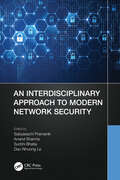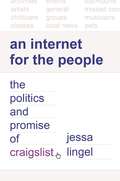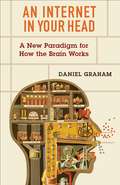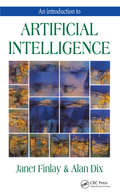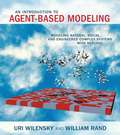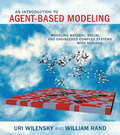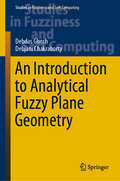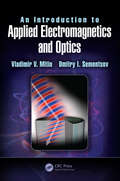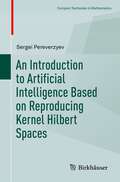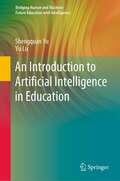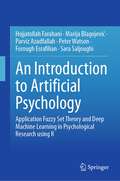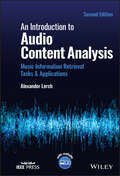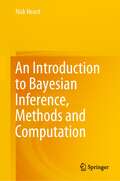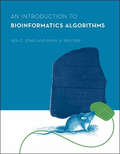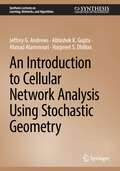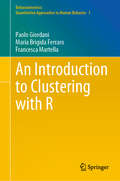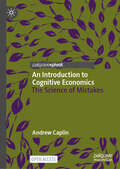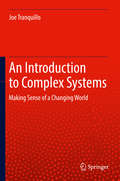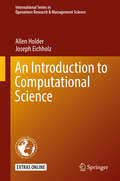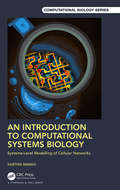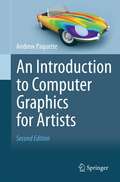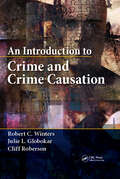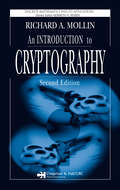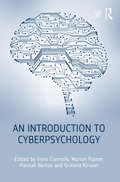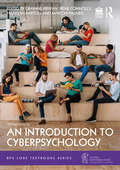- Table View
- List View
An Interdisciplinary Approach to Modern Network Security
by Dac-Nhuong Le Surbhi Bhatia Sabyasachi Pramanik Anand SharmaAn Interdisciplinary Approach to Modern Network Security presents the latest methodologies and trends in detecting and preventing network threats. Investigating the potential of current and emerging security technologies, this publication is an all-inclusive reference source for academicians, researchers, students, professionals, practitioners, network analysts and technology specialists interested in the simulation and application of computer network protection. It presents theoretical frameworks and the latest research findings in network security technologies, while analyzing malicious threats which can compromise network integrity. It discusses the security and optimization of computer networks for use in a variety of disciplines and fields. Touching on such matters as mobile and VPN security, IP spoofing and intrusion detection, this edited collection emboldens the efforts of researchers, academics and network administrators working in both the public and private sectors. This edited compilation includes chapters covering topics such as attacks and countermeasures, mobile wireless networking, intrusion detection systems, next-generation firewalls, web security and much more. Information and communication systems are an essential component of our society, forcing us to become dependent on these infrastructures. At the same time, these systems are undergoing a convergence and interconnection process that has its benefits, but also raises specific threats to user interests. Citizens and organizations must feel safe when using cyberspace facilities in order to benefit from its advantages. This book is interdisciplinary in the sense that it covers a wide range of topics like network security threats, attacks, tools and procedures to mitigate the effects of malware and common network attacks, network security architecture and deep learning methods of intrusion detection.
An Internet for the People: The Politics and Promise of craigslist (Princeton Studies in Culture and Technology #26)
by Professor Jessa LingelHow craigslist champions openness, democracy, and other vanishing principles of the early webBegun by Craig Newmark as an e-mail to some friends about cool events happening around San Francisco, craigslist is now the leading classifieds service on the planet. It is also a throwback to the early internet. The website has barely seen an upgrade since it launched in 1996. There are no banner ads. The company doesn't profit off your data. An Internet for the People explores how people use craigslist to buy and sell, find work, and find love—and reveals why craigslist is becoming a lonely outpost in an increasingly corporatized web.Drawing on interviews with craigslist insiders and ordinary users, Jessa Lingel looks at the site's history and values, showing how it has mostly stayed the same while the web around it has become more commercial and far less open. She examines craigslist's legal history, describing the company's courtroom battles over issues of freedom of expression and data privacy, and explains the importance of locality in the social relationships fostered by the site. More than an online garage sale, job board, or dating site, craigslist holds vital lessons for the rest of the web. It is a website that values user privacy over profits, ease of use over slick design, and an ethos of the early web that might just hold the key to a more open, transparent, and democratic internet.
An Internet in Your Head: A New Paradigm for How the Brain Works
by Daniel GrahamWhether we realize it or not, we think of our brains as computers. In neuroscience, the metaphor of the brain as a computer has defined the field for much of the modern era. But as neuroscientists increasingly reevaluate their assumptions about how brains work, we need a new metaphor to help us ask better questions.The computational neuroscientist Daniel Graham offers an innovative paradigm for understanding the brain. He argues that the brain is not like a single computer—it is a communication system, like the internet. Both are networks whose power comes from their flexibility and reliability. The brain and the internet both must route signals throughout their systems, requiring protocols to direct messages from just about any point to any other. But we do not yet understand how the brain manages the dynamic flow of information across its entire network. The internet metaphor can help neuroscience unravel the brain’s routing mechanisms by focusing attention on shared design principles and communication strategies that emerge from parallel challenges. Highlighting similarities between brain connectivity and the architecture of the internet can open new avenues of research and help unlock the brain’s deepest secrets.An Internet in Your Head presents a clear-eyed and engaging tour of brain science as it stands today and where the new paradigm might take it next. It offers anyone with an interest in brains a transformative new way to conceptualize what goes on inside our heads.
An Introduction To Artificial Intelligence
by Janet FinlayAn authoritative and accessible one-stop resource, An Introduction to Artificial Intelligence presents the first full examination of AI. Designed to provide an understanding of the foundations of artificial intelligence, it examines the central computational techniques employed by AI, including knowledge representation, search, reasoning, and learning, as well as the principal application domains of expert systems, natural language, vision, robotics, software agents and cognitive modeling. Many of the major philosophical and ethical issues of AI are also introduced.Throughout the volume, the authors provide detailed, well-illustrated treatments of each topic with abundant examples and exercises. The authors bring this exciting field to life by presenting a substantial and robust introduction to artificial intelligence in a clear and concise coursebook form. This book stands as a core text for all computer scientists approaching AI for the first time.
An Introduction to Agent-Based Modeling: Modeling Natural, Social, and Engineered Complex Systems with NetLogo
by Uri Wilensky William RandThe advent of widespread fast computing has enabled us to work on more complex problems and to build and analyze more complex models. This book provides an introduction to one of the primary methodologies for research in this new field of knowledge. Agent-based modeling (ABM) offers a new way of doing science: by conducting computer-based experiments. ABM is applicable to complex systems embedded in natural, social, and engineered contexts, across domains that range from engineering to ecology. An Introduction to Agent-Based Modeling offers a comprehensive description of the core concepts, methods, and applications of ABM. Its hands-on approach -- with hundreds of examples and exercises using NetLogo -- enables readers to begin constructing models immediately, regardless of experience or discipline.The book first describes the nature and rationale of agent-based modeling, then presents the methodology for designing and building ABMs, and finally discusses how to utilize ABMs to answer complex questions. Features in each chapter include step-by-step guides to developing models in the main text; text boxes with additional information and concepts; end-of-chapter explorations; and references and lists of relevant reading. There is also an accompanying website with all the models and code.
An Introduction to Agent-Based Modeling: Modeling Natural, Social, and Engineered Complex Systems with NetLogo
by Uri Wilensky William RandA comprehensive and hands-on introduction to the core concepts, methods, and applications of agent-based modeling, including detailed NetLogo examples. The advent of widespread fast computing has enabled us to work on more complex problems and to build and analyze more complex models. This book provides an introduction to one of the primary methodologies for research in this new field of knowledge. Agent-based modeling (ABM) offers a new way of doing science: by conducting computer-based experiments. ABM is applicable to complex systems embedded in natural, social, and engineered contexts, across domains that range from engineering to ecology. An Introduction to Agent-Based Modeling offers a comprehensive description of the core concepts, methods, and applications of ABM. Its hands-on approach—with hundreds of examples and exercises using NetLogo—enables readers to begin constructing models immediately, regardless of experience or discipline. The book first describes the nature and rationale of agent-based modeling, then presents the methodology for designing and building ABMs, and finally discusses how to utilize ABMs to answer complex questions. Features in each chapter include step-by-step guides to developing models in the main text; text boxes with additional information and concepts; end-of-chapter explorations; and references and lists of relevant reading. There is also an accompanying website with all the models and code.
An Introduction to Analytical Fuzzy Plane Geometry (Studies in Fuzziness and Soft Computing #381)
by Debdas Ghosh Debjani ChakrabortyThis book offers a rigorous mathematical analysis of fuzzy geometrical ideas. It demonstrates the use of fuzzy points for interpreting an imprecise location and for representing an imprecise line by a fuzzy line. Further, it shows that a fuzzy circle can be used to represent a circle when its description is not known precisely, and that fuzzy conic sections can be used to describe imprecise conic sections. Moreover, it discusses fundamental notions on fuzzy geometry, including the concepts of fuzzy line segment and fuzzy distance, as well as key fuzzy operations, and includes several diagrams and numerical illustrations to make the topic more understandable. The book fills an important gap in the literature, providing the first comprehensive reference guide on the fuzzy mathematics of imprecise image subsets and imprecise geometrical objects. Mainly intended for researchers active in fuzzy optimization, it also includes chapters relevant for those working on fuzzy image processing and pattern recognition. Furthermore, it is a valuable resource for beginners interested in basic operations on fuzzy numbers, and can be used in university courses on fuzzy geometry, dealing with imprecise locations, imprecise lines, imprecise circles, and imprecise conic sections.
An Introduction to Applied Electromagnetics and Optics
by Vladimir V. Mitin Dmitry I. SementsovModern technology is rapidly developing and for this reason future engineers need to acquire advanced knowledge in science and technology, including electromagnetic phenomena. This book is a contemporary text of a one-semester course for junior electrical engineering students. It covers a broad spectrum of electromagnetic phenomena such as, surface waves, plasmas, photonic crystals, negative refraction as well as related materials including superconductors. In addition, the text brings together electromagnetism and optics as the majority of texts discuss electromagnetism disconnected from optics. In contrast, in this book both are discussed. Seven labs have been developed to accompany the material of the book.
An Introduction to Artificial Intelligence Based on Reproducing Kernel Hilbert Spaces (Compact Textbooks in Mathematics)
by Sergei PereverzyevThis textbook provides an in-depth exploration of statistical learning with reproducing kernels, an active area of research that can shed light on trends associated with deep neural networks. The author demonstrates how the concept of reproducing kernel Hilbert Spaces (RKHS), accompanied with tools from regularization theory, can be effectively used in the design and justification of kernel learning algorithms, which can address problems in several areas of artificial intelligence. Also provided is a detailed description of two biomedical applications of the considered algorithms, demonstrating how close the theory is to being practically implemented. Among the book’s several unique features is its analysis of a large class of algorithms of the Learning Theory that essentially comprise every linear regularization scheme, including Tikhonov regularization as a specific case. It also provides a methodology for analyzing not only different supervised learning problems, such as regression or ranking, but also different learning scenarios, such as unsupervised domain adaptation or reinforcement learning. By analyzing these topics using the same theoretical framework, rather than approaching them separately, their presentation is streamlined and made more approachable.An Introduction to Artificial Intelligence Based on Reproducing Kernel Hilbert Spaces is an ideal resource for graduate and postgraduate courses in computational mathematics and data science.
An Introduction to Artificial Intelligence in Education (Bridging Human and Machine: Future Education with Intelligence)
by Shengquan Yu Yu LuThis book systematically reviews a broad range of cases in education that utilize cutting-edge AI technologies. Furthermore, it introduces readers to the latest findings on the scope of AI in education, so as to inspire researchers from non-technological fields (e.g. education, psychology and neuroscience) to solve education problems using the latest AI techniques. It also showcases a number of established AI systems and products that have been employed for education. Lastly, the book discusses how AI can offer an enabling technology for critical aspects of education, typically including the learner, content, strategy, tools and environment, and what breakthroughs and advances the future holds.The book provides an essential resource for researchers, students and industrial practitioners interested and engaged in the fields of AI and education. It also offers a convenient handbook for non-professional readers who need a primer on AI in education, and who want to gain a deeper understanding of emerging trends in this domain.
An Introduction to Artificial Psychology: Application Fuzzy Set Theory and Deep Machine Learning in Psychological Research using R
by Peter Watson Sara Saljoughi Hojjatollah Farahani Marija Blagojević Parviz Azadfallah Forough EsrafilianArtificial Psychology (AP) is a highly multidisciplinary field of study in psychology. AP tries to solve problems which occur when psychologists do research and need a robust analysis method. Conventional statistical approaches have deep rooted limitations. These approaches are excellent on paper but often fail to model the real world. Mind researchers have been trying to overcome this by simplifying the models being studied. This stance has not received much practical attention recently. Promoting and improving artificial intelligence helps mind researchers to find a holistic model of mental models. This development achieves this goal by using multiple perspectives and multiple data sets together with interactive, and realistic models. In this book, the methodology of approximate inference in psychological research from a theoretical and practical perspective has been considered. Quantitative variable-oriented methodology and qualitative case-oriented methods are both used to explain the set-oriented methodology and this book combines the precision of quantitative methods with information from qualitative methods. This is a book that many researchers can use to expand and deepen their psychological research and is a book which can be useful to postgraduate students. The reader does not need an in-depth knowledge of mathematics or statistics because statistical and mathematical intuitions are key here and they will be learned through practice. What is important is to understand and use the new application of the methods for finding new, dynamic and realistic interpretations. This book incorporates theoretical fuzzy inference and deep machine learning algorithms in practice. This is the kind of book that we wished we had had when we were students. This book covers at least some of the most important issues in mind research including uncertainty, fuzziness, continuity, complexity and high dimensionality which are inherent to mind data. These are elements of artificial psychology. This book implements models using R software.
An Introduction to Audio Content Analysis: Music Information Retrieval Tasks and Applications
by Alexander LerchAn Introduction to Audio Content Analysis Enables readers to understand the algorithmic analysis of musical audio signals with AI-driven approaches An Introduction to Audio Content Analysis serves as a comprehensive guide on audio content analysis explaining how signal processing and machine learning approaches can be utilized for the extraction of musical content from audio. It gives readers the algorithmic understanding to teach a computer to interpret music signals and thus allows for the design of tools for interacting with music. The work ties together topics from audio signal processing and machine learning, showing how to use audio content analysis to pick up musical characteristics automatically. A multitude of audio content analysis tasks related to the extraction of tonal, temporal, timbral, and intensity-related characteristics of the music signal are presented. Each task is introduced from both a musical and a technical perspective, detailing the algorithmic approach as well as providing practical guidance on implementation details and evaluation. To aid in reader comprehension, each task description begins with a short introduction to the most important musical and perceptual characteristics of the covered topic, followed by a detailed algorithmic model and its evaluation, and concluded with questions and exercises. For the interested reader, updated supplemental materials are provided via an accompanying website. Written by a well-known expert in the music industry, sample topics covered in Introduction to Audio Content Analysis include: Digital audio signals and their representation, common time-frequency transforms, audio features Pitch and fundamental frequency detection, key and chord Representation of dynamics in music and intensity-related features Beat histograms, onset and tempo detection, beat histograms, and detection of structure in music, and sequence alignment Audio fingerprinting, musical genre, mood, and instrument classification An invaluable guide for newcomers to audio signal processing and industry experts alike, An Introduction to Audio Content Analysis covers a wide range of introductory topics pertaining to music information retrieval and machine listening, allowing students and researchers to quickly gain core holistic knowledge in audio analysis and dig deeper into specific aspects of the field with the help of a large amount of references.
An Introduction to Bayesian Inference, Methods and Computation
by Nick HeardThese lecture notes provide a rapid, accessible introduction to Bayesian statistical methods. The course covers the fundamental philosophy and principles of Bayesian inference, including the reasoning behind the prior/likelihood model construction synonymous with Bayesian methods, through to advanced topics such as nonparametrics, Gaussian processes and latent factor models. These advanced modelling techniques can easily be applied using computer code samples written in Python and Stan which are integrated into the main text. Importantly, the reader will learn methods for assessing model fit, and to choose between rival modelling approaches.
An Introduction to Bioinformatics Algorithms (Computational Molecular Biology)
by Neil C. Jones Pavel A. PevznerAn introductory text that emphasizes the underlying algorithmic ideas that are driving advances in bioinformatics.This introductory text offers a clear exposition of the algorithmic principles driving advances in bioinformatics. Accessible to students in both biology and computer science, it strikes a unique balance between rigorous mathematics and practical techniques, emphasizing the ideas underlying algorithms rather than offering a collection of apparently unrelated problems. The book introduces biological and algorithmic ideas together, linking issues in computer science to biology and thus capturing the interest of students in both subjects. It demonstrates that relatively few design techniques can be used to solve a large number of practical problems in biology, and presents this material intuitively. An Introduction to Bioinformatics Algorithms is one of the first books on bioinformatics that can be used by students at an undergraduate level. It includes a dual table of contents, organized by algorithmic idea and biological idea; discussions of biologically relevant problems, including a detailed problem formulation and one or more solutions for each; and brief biographical sketches of leading figures in the field. These interesting vignettes offer students a glimpse of the inspirations and motivations for real work in bioinformatics, making the concepts presented in the text more concrete and the techniques more approachable.PowerPoint presentations, practical bioinformatics problems, sample code, diagrams, demonstrations, and other materials can be found at the Author's website.
An Introduction to Cellular Network Analysis Using Stochastic Geometry (Synthesis Lectures on Learning, Networks, and Algorithms)
by Harpreet S. Dhillon Jeffrey G. Andrews Abhishek K. Gupta Ahmad AlammouriThis book provides an accessible yet rigorous first reference for readers interested in learning how to model and analyze cellular network performance using stochastic geometry. In addition to the canonical downlink and uplink settings, analyses of heterogeneous cellular networks and dense cellular networks are also included. For each of these settings, the focus is on the calculation of coverage probability, which gives the complementary cumulative distribution function (ccdf) of signal-to-interference-and-noise ratio (SINR) and is the complement of the outage probability. Using this, other key performance metrics, such as the area spectral efficiency, are also derived. These metrics are especially useful in understanding the effect of densification on network performance. In order to make this a truly self-contained reference, all the required background material from stochastic geometry is introduced in a coherent and digestible manner.This Book:Provides an approachable introduction to the analysis of cellular networks and illuminates key system dependenciesFeatures an approach based on stochastic geometry as applied to cellular networks including both downlink and uplinkFocuses on the statistical distribution of signal-to-interference-and-noise ratio (SINR) and related metrics
An Introduction to Clustering with R (Behaviormetrics: Quantitative Approaches to Human Behavior #1)
by Maria Brigida Ferraro Paolo Giordani Francesca MartellaThe purpose of this book is to thoroughly prepare the reader for applied research in clustering. Cluster analysis comprises a class of statistical techniques for classifying multivariate data into groups or clusters based on their similar features. Clustering is nowadays widely used in several domains of research, such as social sciences, psychology, and marketing, highlighting its multidisciplinary nature. This book provides an accessible and comprehensive introduction to clustering and offers practical guidelines for applying clustering tools by carefully chosen real-life datasets and extensive data analyses. The procedures addressed in this book include traditional hard clustering methods and up-to-date developments in soft clustering. Attention is paid to practical examples and applications through the open source statistical software R. Commented R code and output for conducting, step by step, complete cluster analyses are available. The book is intended for researchers interested in applying clustering methods. Basic notions on theoretical issues and on R are provided so that professionals as well as novices with little or no background in the subject will benefit from the book.
An Introduction to Cognitive Economics: The Science of Mistakes
by Andrew CaplinThis book introduces readers to “cognitive economics,” a rapidly emerging interdisciplinary science built on economic, psychological, and data scientific foundations. Throughout the book, economist Andrew Caplin provides new approaches to help scholars collaborate and solve problems that can shape economic outcomes and bridge the gap between theoretical knowledge and the real world. Divided into two parts, the first section brings readers up to speed on economic concepts that underlie decision-making mistakes, such as utility functions, subjective beliefs, and costs of learning. It also explores real-world applications, including improvements in legal decision-making, online privacy protection, and optimizing human-AI collaboration. The book also discusses the future impact of AI on the workforce and emphasizes the need for decision-making skills and financial literacy in navigating this evolving landscape. In the second section of the book, Caplin addresses the barriers to progress within social sciences, advocating for interdisciplinary cooperation and innovative measurement techniques to advance the field. The book invites readers to contribute to the development of cognitive economics. Whether you are a socially-conscious and hard-working citizen, business leader, scholar, or policymaker, this book will help you understand why cognitive economics matters to you and how you can contribute to its takeoff. This book is available open access, which means it is freely available online.
An Introduction to Complex Systems: Making Sense of a Changing World
by Joe TranquilloThis book explores the interdisciplinary field of complex systems theory. By the end of the book, readers will be able to understand terminology that is used in complex systems and how they are related to one another; see the patterns of complex systems in practical examples; map current topics, in a variety of fields, to complexity theory; and be able to read more advanced literature in the field. The book begins with basic systems concepts and moves on to how these simple rules can lead to complex behavior. The author then introduces non-linear systems, followed by pattern formation, and networks and information flow in systems. Later chapters cover the thermodynamics of complex systems, dynamical patterns that arise in networks, and how game theory can serve as a framework for decision making. The text is interspersed with both philosophical and quantitative arguments, and each chapter ends with questions and prompts that help readers make more connections.
An Introduction to Computational Science (International Series in Operations Research & Management Science #278)
by Allen Holder Joseph EichholzThis textbook provides an introduction to the growing interdisciplinary field of computational science. It combines a foundational development of numerical methods with a variety of illustrative applications spread across numerous areas of science and engineering. The intended audience is the undergraduate who has completed introductory coursework in mathematics and computer science. Students gain computational acuity by authoring their own numerical routines and by practicing with numerical methods as they solve computational models. This education encourages students to learn the importance of answering: How expensive is a calculation, how trustworthy is a calculation, and how might we model a problem to apply a desired numerical method?The text is written in two parts. Part I provides a succinct, one-term inauguration into the primary routines on which a further study of computational science rests. The material is organized so that the transition to computational science from coursework in calculus, differential equations, and linear algebra is natural. Beyond the mathematical and computational content of Part I, students gain proficiency with elemental programming constructs and visualization, which are presented in MATLAB syntax. The focus of Part II is modeling, wherein students build computational models, compute solutions, and report their findings. The models purposely intersect numerous areas of science and engineering to demonstrate the pervasive role played by computational science.
An Introduction to Computational Systems Biology: Systems-Level Modelling of Cellular Networks (Chapman & Hall/CRC Computational Biology Series)
by Karthik Raman"This is a very comprehensive read that provides a solid base in computational biology. The book is structured in 4 parts and 14 chapters which cover all the way from the more basic concepts to advanced material, including the state-of-the-art methodologies in synthetic and systems biology. This is a bedside book for those researchers embarking to do investigation in computational biology and a great office companion for anyone working on systems and synthetic biology." -- Rodrigo Ledesma Amaro, Lecturer, Imperial College London "This is a fantastic book. It offers an elegant introduction to both classical and modern concepts in computational biology. To the uninitiated, it is a terrific first read, bringing alive the glory of the past and the promise of the future. To the interested, it handholds and offers a springboard to dive deep. To the practitioner, it serves as a valuable resource bringing together in a panoramic view many diverse streams that adorn the landscape." -- Narendra M. Dixit, Professor, Indian Institute of Science An Introduction to Computational Systems Biology: Systems-Level Modelling of Cellular Networks delivers a comprehensive and insightful account of applying mathematical modelling approaches to very large biological systems and networks—a fundamental aspect of computational systems biology. The book covers key modelling paradigms in detail, while at the same time retaining a simplicity that will appeal to those from less quantitative fields. Features A hands-on approach to modelling Covers a broad spectrum of modelling, from static networks to dynamic models and constraint-based models Thoughtful exercises to test and enable understanding of concepts State-of-the-art chapters on exciting new developments like community modelling and biological circuit design Emphasis on coding and software tools for systems biology This book is highly multi-disciplinary and will appeal to biologists, engineers, computer scientists, mathematicians and others.
An Introduction to Computer Graphics for Artists
by Andrew PaquetteAn Introduction to Computer Graphics for Artists is an application-independent, reader-friendly primer for anyone with a serious desire to understand 3D Computer Graphics. Written by a veteran of the computer graphics industry whose previous career included film animation and various spells as Art Director for video games, Andrew Paquette draws on his experiences both as an artist and a manager. Far too often artists, even professionals, lack a basic understanding of the principles of computer graphics. The result is inefficiency and lower quality of work. This book addresses these issues by providing fundamental information in a university course format, with theoretical material, detailed illustrations, and projects to test the reader's understanding of the concepts covered. Opening with the first and most basic elements of computer graphics, the book rapidly advances into progressively more complex concepts. Each of the elements, however simple, are important to understand because each is an essential link in a chain that allows an artist to master any computer graphics application. With this accomplished, the artist can use technology to satisfy his goals, instead of the technology being master of the artist. All students wanting to learn more about computer graphics from an artistic viewpoint, particularly those intending to pursue a career in computer game design or film animation, will find this book invaluable.
An Introduction to Crime and Crime Causation
by Cliff Roberson Robert C. Winters Julie L. GlobokarAn Introduction to Crime and Crime Causation is a student-friendly textbook that defines and explains the concepts of crime, criminal law, and criminology. Ideal for a one-semester course, the book compares and contrasts early criminal behavior and today‘s modern forms of crime. It also explores society‘s responses to criminal behavior in the past
An Introduction to Cryptography (Discrete Mathematics and Its Applications)
by Richard A. MollinContinuing a bestselling tradition, An Introduction to Cryptography, Second Edition provides a solid foundation in cryptographic concepts that features all of the requisite background material on number theory and algorithmic complexity as well as a historical look at the field.With numerous additions and restructured material, this edition
An Introduction to Cyberpsychology
by Irene Connolly, Palmer Marion, Barton Hannah and Kirwan GráinneAn Introduction to Cyberpsychology is the first book to provide a student-oriented introduction to this rapidly growing and increasingly studied topic. It is designed to encourage students to critically evaluate the psychology of online interactions, and to develop appropriate research methodologies to complete their own work in this field. The book is comprised of four main sections: An overview of cyberpsychology and online research methodologies Social psychology in an online context The practical applications of cyberpsychology The psychological aspects of other technologies. Each chapter includes: Explanations of key terms and a glossary to facilitate understanding Content summaries to aid student learning Activity boxes, discussion questions and recommended reading to guide further study. Further resources for students and instructors are available on the book’s companion website, including audio and video links, essay questions, a multiple-choice test bank, and PowerPoint lecture slides. Uniquely combining a survey of the field with a focus on the applied areas of psychology, the book is designed to be a core text for undergraduate modules in cyberpsychology and the psychology of the internet, and a primer for students of postgraduate programs in cyberpsychology.
An Introduction to Cyberpsychology (BPS Core Textbooks Series)
by Gráinne Kirwan, Irene Connolly, Hannah Barton, and Marion PalmerAn Introduction to Cyberpsychology provides a comprehensive introduction to this rapidly growing discipline. Fully updated in its second edition, the book encourages students to critically evaluate the psychology of online interactions and to develop appropriate research methodologies to complete their own work in this field.The book examines cyberpsychology and online research methodologies, social psychology in an online context, practical applications of cyberpsychology, and the psychological aspects of other technologies. This new edition has been carefully updated to include additional coverage of: Expanded content relating to major developments in the field and new content on gaming and screentime A new chapter examining the relationship between older adults and technology Cyberpsychology in focus feature boxes in each chapter that examine topics in depth Interviews with professionals working in fields relating to cyberpsychology Each chapter includes key terms and a glossary, content summaries, discussion questions, and recommended reading to guide further study.Supported by extensive online resources for students and instructors, this authoritative book is an essential core text for undergraduate modules in cyberpsychology, and an ideal primer for students of postgraduate programs in cyberpsychology.To view the additional student and instructor resources for this book, please visit bpscoretextbooks.routledge.com
